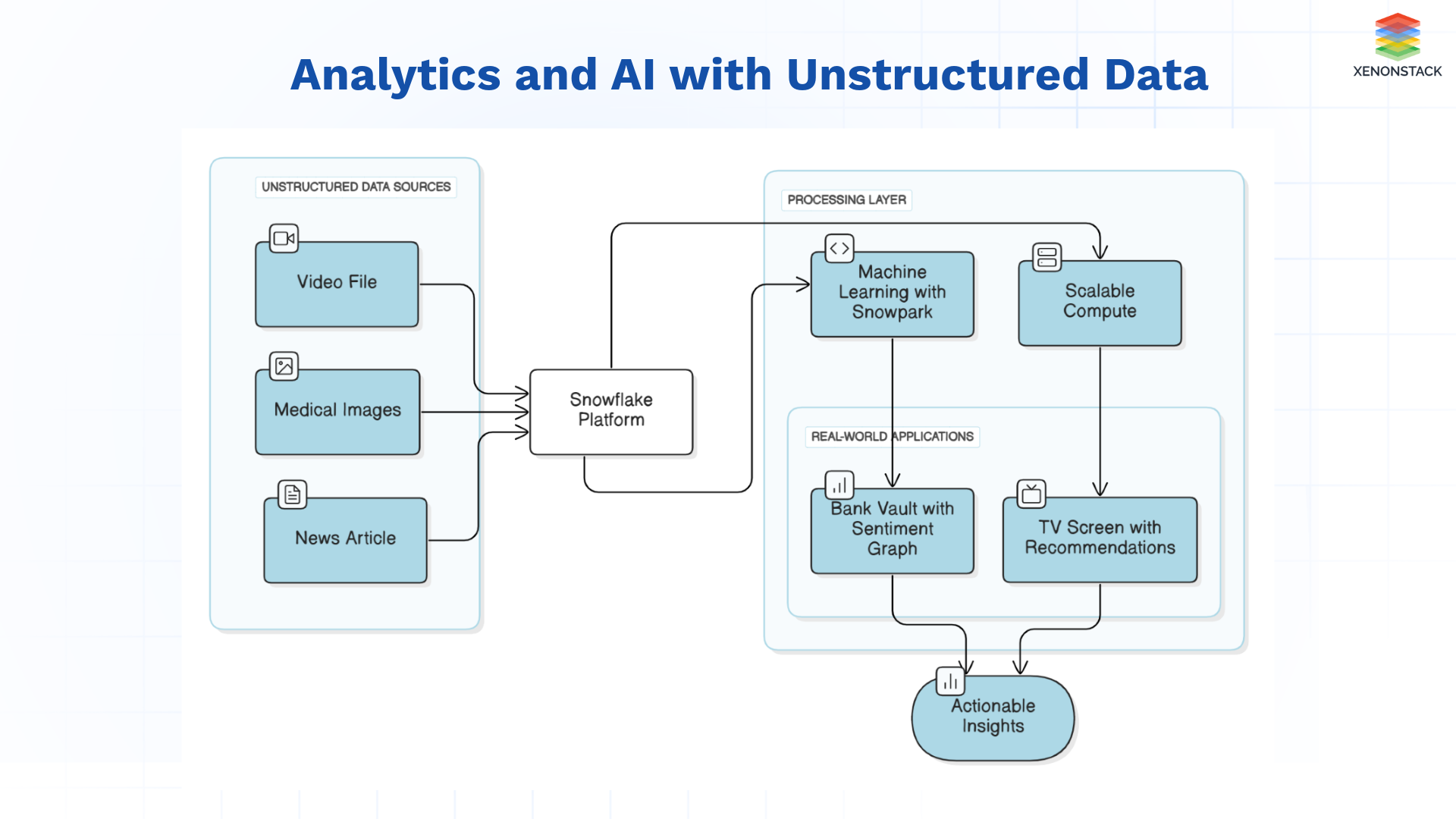Transforming Enterprise Text Files and Documents
Text-heavy documents—such as contracts, customer feedback, and reports—are common unstructured data in enterprises. Snowflake transforms these files into usable insights through a combination of ingestion, processing, and analysis:
 Fig 1: Enterprise Text Files and Documents
Fig 1: Enterprise Text Files and Documents -
Data Ingestion: Snowflake supports loading text files (e.g., CSV, JSON, or raw text) into its stages. Once ingested, these files can be processed using Snowflake’s tools or external integrations.
-
Unstrctured Data: Using Snowpark, enterprises can leverage Python libraries to perform tasks like natural language processing (NLP) or keyword extraction. For example, a company might analyse customer emails to identify sentiment trends or extract critical clauses from legal documents.
-
Upload to Snowflake: Snowflake allows automated file processing through its Streams and Tasks features, which work on incoming files as soon as they become available. These features maintain constant insights by facilitating automatic data retrieval from newly uploaded documents.
Suppose a business needs to review thousands of customer support emails. Snowflake can import emails, extract key phrases or sentiments using Snowpark, and transform unstructured text into structured data for reporting—all on one platform.
Integrating Unstructured Data with Structured Data
The magic happens when unstructured data combines with structured data, providing a 360-degree view of business operations. Snowflake accomplishes that integration very effectively:
-
Unified Platform: Snowflake stores structured (i.e., sales transactions) and unstructured data (i.e., product reviews) within one setting, eliminating silos and simplifying access.
-
Data Joining: One can join structured and unstructured data through SQL queries. For instance, a retailer can join sales volume with customer feedback to determine why specific products trail.
-
Rich Analytics: This offers more robust analytics capabilities, such as connecting purchase activity with customer feedback to inform marketing efforts.
Breaking down data types of silos, Snowflake enables companies to uncover insights unavailable if they work with only structured or unstructured data.
Analytics and AI with Unstructured Data
Beyond basic processing, Snowflake supports advanced analytics and artificial intelligence (AI) to maximize the value of unstructured data:
 Figure 2: Analytics and AI with Unstructured Data
Figure 2: Analytics and AI with Unstructured Data -
Machine Learning with Snowpark: Snowpark allows machine learning models to be created and deployed in Snowflake using libraries like TensorFlow or scikit-learn. For example, a healthcare provider could utilise medical images to contribute to diagnoses.
-
Scalable Compute: Snowflake's architecture dynamically scales compute resources so that even larger-scale AI workloads—e.g., training models on video transcripts—run efficiently.
-
Real-World Applications: A bank can use Snowflake to analyse news headlines for sentiment and predict market fluctuations, and a media company can analyse video metadata to suggest content to users.
These capabilities position Snowflake as an industry-leading platform for companies seeking to harness AI and analytics on their unstructured data.
Security and Governance of Unstructured Data
Unstructured data often contains sensitive data, so security and governance are essential. Snowflake addresses these issues with robust capabilities:
-
Encryption: Data, including unstructured files, is encrypted at rest and in transit. Internal stages offer server-side encryption for additional safeguarding.
-
Access Control: Role-based access control (RBAC) only limits users with valid permissions to view or process specific files while sensitive data remains secure.
-
Compliance Tools: Audit logs and data masking enable companies to adhere to regulatory rules, such as GDPR or HIPAA, when handling unstructured data.
-
Secure Sharing: Snowflake offers safe data sharing with external partners using scoped URLS while allowing access and utilisation control.
Case Studies and Success Stories
To highlight Snowflake’s impact, here are two hypothetical success stories:
Manufacturing Company: A manufacturing business uses Snowflake to process IoT sensor data (unstructured) and manufacturing data (structured). Based on such data, the company predicts equipment downtime, lowering downtime by 20%.
Media Firm: A streaming firm uses Snowflake to analyse video transcripts and viewer engagement metrics. It applies this to build targeted recommendations that boost subscriber retention by 1.
The above explains how Snowflake converts unstructured data into tangible business outcomes across industries.
Transform Your Unstructured Data with Snowflake
Unstructured data presents companies with opportunities and challenges. Snowflake, which can store, process, and analyse text files and documents, among other things, provides the whole solution to realising its potential. It empowers companies to convert raw data into strategic assets by combining unstructured and structured data, supporting future-proofed advanced analytics and AI functionality, and providing sophisticated security.
As the volume of unstructured data keeps growing, Snowflakes and similar companies will play increasingly vital roles in enabling businesses to gain an edge. Whether unlocking insights from customer surveys or powering AI-driven innovations, Snowflake is transforming how businesses leverage their unstructured data, unlocking the potential for a future built on data.
.webp?width=1921&height=622&name=usecase-banner%20(1).webp)




